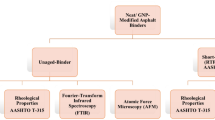Abstract
Long-term thermal and ultraviolet (UV) aging procedures of asphalt mixtures are complicated, but can be simulated in the laboratory. The objective of this study was to investigate the influence of long-term thermal and UV aging on foamed warm-mix asphalt (WMA) mixtures. Rut resistance, indirect tensile strength (ITS), deformation, dissipated elastic energy, and fracture energy were measured for all mixtures. The experimental design included two aggregate sources; three aging states (unaged, thermal and UV aging); one water-bearing WMA additive and water foaming technology; two PG 64-22 binders, and three air void contents (2, 4, and 7 %). A total of 24 mixtures were evaluated and 144 specimens were made and tested in this study. The test results indicated that thermal and UV aging procedures had limited contribution in improving the rut resistance of a mixture as air void content was low. Unaged samples had the highest ITS values amongst three aging states while UV aged samples had the lowest. In addition, UV aged mixtures generally had greater dissipated energy than thermal aged mixtures regardless of foaming technology, aggregate source, and air void. Moreover, the foaming technology might reduce the stored elastic energy of the mixture due to additional water or released water from water-bearing additive. Furthermore, UV aging generally reduces the fracture resistance of an asphalt mixture than standard thermal aging. In addition, when using WMA foaming technology, aggregate source affects the fracture resistance of the asphalt mixture.










Similar content being viewed by others
References
D’Angelo J, Harm E, Bartoszek J, Baumgardner G, Corrigan M, Cowsert J, Harman T, Jamshidi M, Jones W, Newcomb D, Prowell B, Sines R, Yeaton B (2008) Warm mix asphalt: European practice. FHWA-PL-08-007, FHWA, U.S. DOT, Washington, DC
Prowell BD, Hurley GC (2007) Warm-mix asphalt: best practices. National Asphalt Pavement Association, Lanham
Xiao F, Amirkhanian SN (2010) Effects of liquid antistrip additives on rheology and moisture susceptibility of water bearing warm mixtures. Constr Build Mater 24(9):1649–1655
Middleton B, Forfylow RW (2009) Evaluation of warm-mix asphalt produced with the double barrel green process. TRR 2126:19–26
Wielinski J, Hand A, Rausch DM (2009) Laboratory and field evaluations of foamed warm-mix asphalt projects. TRR 2126:125–131
Huang SC, Zeng ML (2007) Characterization of aging effect on rheological properties of asphalt-filler systems. Int J Pavement Eng 8(3):213–223
Gandhi T (2008) Effects of warm asphalt additives on asphalt binder and mixture properties. PhD dissertation, Clemson University, Clemson
Ye F, Yang J, Huang P (2006) Performance of modified asphalt aging under ultraviolet radiation. In: Pavement mechanics and performance (GSP 154), ASCE, Atlanta, pp 102–109
Wang J, Tan Y, Xue Z, Feng Z, Xu H (2007) Analysis on property changes of neat and modified asphalt under ultraviolet aging. In: Pavements and materials: characterization, modeling, and simulation (GSP 182), ASCE, Atlanta
Wu S, Pang L, Liu G, Zhu J (2010) Laboratory study on ultraviolet radiation aging of bitumen. J Mater Civ Eng 22(8):767–772
Zoorob SE, Suparma LB (2000) Laboratory design and investigation of the properties of continuously graded Asphaltic concrete containing recycled plastics aggregate replacement (Plastiphalt). Cem Concr Compos 22:233–242
Xiao F, Zhao W, Gandhi T, Amirkhanian SN (2010) Influence of anti-stripping additive on moisture susceptibility of warm mix asphalt mixture. J Mater Civ Eng 22(10):1047–1055
Xiao F, Punith VS, Putman BJ, Amirkhanian SN (2011) Utilization of foaming technology in warm mix asphalt mixtures containing moist aggregates. J Mater Civ Eng 23(9):1328–1337
Xiao F, Jordan J, Amirkhanian S (2009) Laboratory investigation of moisture damage in warm-mix asphalt containing moist aggregate. TRR 2126:115–124
Punith VS, Xiao F, Putman BJ, Amirkhanian SN (2012) Effects of a long-term aging procedure on moisture sensitivity of foamed WMA mixtures containing moist aggregates. Mater Struct 45(1):251–264
Byars EF, Snyder RD, Plants HL (1983) Engineering mechanics of deformable bodies, 4th edn. Harper & Row, New York
Kim YR, Wen H (2002) Fracture energy from indirect tension testing. J Assoc Asphalt Paving Technol 71:779–793
Shu X, Huang B, Vukosavljevic D (2008) Laboratory evaluation of fatigue characteristics of recycled asphalt mixture. Constr Build Mater 22(7):1323–1330
Roberts FL, Kandhal PS, Brown ER, Lee D, Kennedy TW (1996) Hot mix asphalt materials, mixture design, and construction. NAPA Research and Education Foundation, Lanham
Author information
Authors and Affiliations
Corresponding author
Rights and permissions
About this article
Cite this article
Xiao, F., Newton, D., Putman, B. et al. A long-term ultraviolet aging procedure on foamed WMA mixtures. Mater Struct 46, 1987–2001 (2013). https://doi.org/10.1617/s11527-013-0031-7
Received:
Accepted:
Published:
Issue Date:
DOI: https://doi.org/10.1617/s11527-013-0031-7




